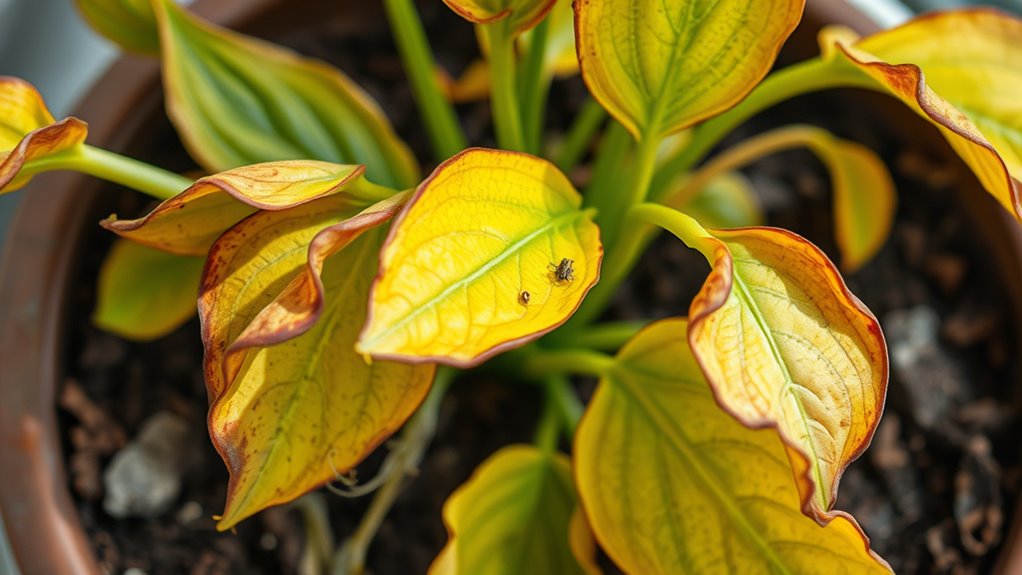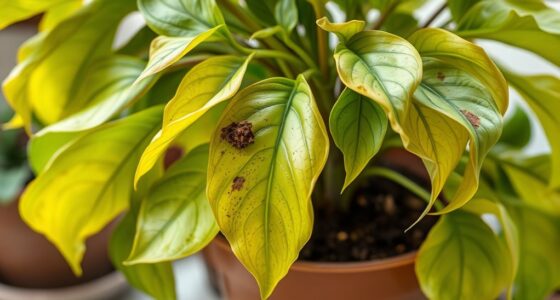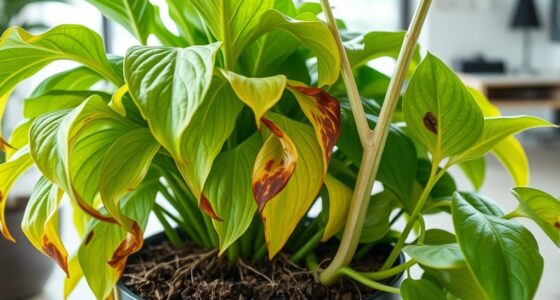If your plant is showing signs like curling leaves, mottling, tiny pests, sticky residue, webbing, or black sooty mold, it’s likely dealing with pests or stress. Look closely at the undersides of leaves and stems for tiny insects or damage signs. Poor health from over or under-watering, improper lighting, and environmental stress can also cause problems. Spotting these issues early helps you take effective steps—keep going to learn how to keep your plant healthy.
Key Takeaways
- Look for pest signs like webbing, sticky residue, or black mold, which indicate infestations.
- Check for leaf damage such as curling, mottling, or leaf fall as symptoms of health issues.
- Observe plant vigor; poor growth or yellowing suggests nutritional or watering problems.
- Inspect the undersides of leaves and stems regularly for tiny pests or eggs.
- Ensure optimal environmental conditions—proper lighting, watering, and soil health—to reduce stress and prevent problems.

Speaking of pests, pest identification is another key step in diagnosing plant problems. Tiny insects like aphids, spider mites, or scale can silently damage your plant by sucking sap, causing leaves to curl, become mottled, or fall off. Look closely at the undersides of leaves and stems; tiny specks or sticky residue often signal pest activity. Some pests also produce webbing or leave behind black sooty mold. If you notice these signs, treat the infestation promptly with appropriate insecticidal soap or neem oil. Not only does this help eliminate pests, but it also prevents further damage, giving your plant a better chance to recover. Sometimes, pests aren’t immediately visible, so inspecting regularly is vital. Additionally, healthy plants are better equipped to resist pests, so ensuring ideal watering and proper soil conditions forms the foundation of good defense. Moreover, understanding the contrast ratio of your lighting setup can help you create an environment that reduces plant stress and discourages pest infestations.
Frequently Asked Questions
How Often Should I Water My Plant During Winter?
During winter, you should adjust your watering schedule to match winter moisture needs. Typically, watering once every 2-3 weeks is enough, but it depends on your plant’s environment and type. Always check the soil first; if it’s dry a few inches down, it’s time to water. Overwatering can lead to root rot, so verify your plant’s pot drains well and avoid watering on a fixed schedule.
Can Over-Fertilizing Harm My Plant?
Did you know that 30% of plant problems stem from fertilizer overload? Yes, over-fertilizing can harm your plant through nutrient toxicity, which damages roots and leaves. You should always follow the recommended fertilizer amounts, as too much can lead to stunted growth or even kill the plant. Be cautious, and remember that more fertilizer isn’t always better—balance is key to healthy, thriving plants.
What Pests Are Common in Indoor Plants?
When it comes to common indoor pests, you should look out for spider mites, aphids, and mealybugs. Pest identification is key, so inspect your plants regularly for tiny insects or sticky residue. To prevent infestations, maintain healthy humidity levels, avoid overwatering, and keep leaves clean. If you spot pests early, insect prevention becomes easier, helping your plants stay healthy and vibrant without the need for harsh chemicals.
How Do I Revive a Plant With Yellowing Leaves?
Imagine your plant struggling to stay vibrant, its yellowing leaves whispering for help. To revive it, start by inspecting for root rot—firm, dark roots indicate trouble. Trim away affected roots and repot in fresh soil with proper drainage. Guarantee it gets adequate light and water. Address leaf discoloration by adjusting watering habits and fertilizing appropriately. With patience, your plant can regain its health and beauty.
Is It Normal for My Plant to Lose Leaves Naturally?
It’s normal for your plant to shed leaves naturally, especially during seasonal changes. Leaf shedding helps the plant adapt to its environment and conserve energy. You might notice some leaves falling off without any other issues. Keep an eye on overall health, and if the shedding increases or is accompanied by other problems like yellowing or wilting, then it’s time to check for other causes. Otherwise, this is just part of its natural cycle.
Conclusion
So, next time your plant seems off, remember these signs—sometimes, a little change in color or droopiness is just a coincidence. Don’t jump to conclusions; often, a quick check can reveal a simple fix. Your plant’s health might be trying to tell you something, just like how a sudden bloom or a drop in leaves can happen unexpectedly. Trust your instincts, stay observant, and your green friend will thrive again before you know it.









